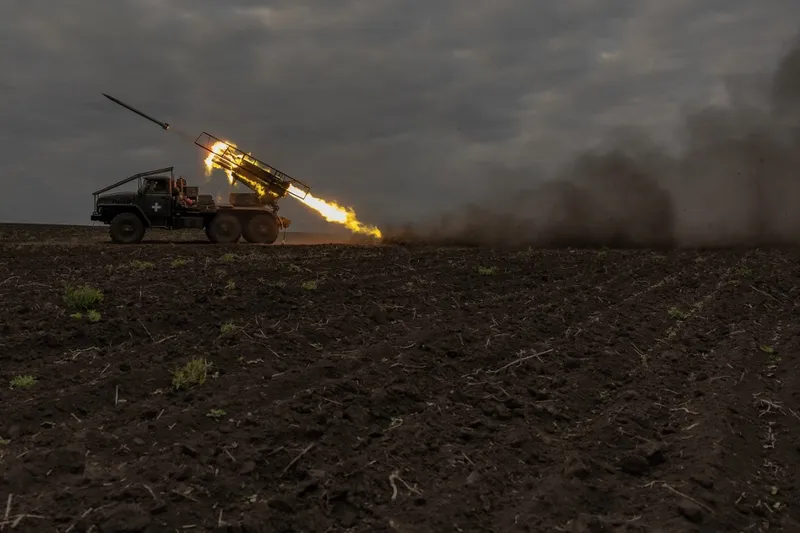
Russia announced last Wednesday, the 15th, that it took control of new Ukrainian territories in the direction of Kharkov, one of the country’s largest cities. The Ukrainian Armed Forces acknowledged the withdrawal of its troops in the eastern part of the territory, claiming that the reason was “to save the lives of soldiers and avoid losses”.
The Russian advance came two days after Russian President Vladimir Putin announced that Andrei Belousov will be the country’s new Defense Minister, replacing Serguei Shoigu, who had been in the position for 12 years. In a meeting that formalized the formation of the new presidential cabinet, last Wednesday (13), Putin made a point of highlighting the recent successes of Russian forces in Ukraine.
“Our troops are constantly, every day, improving their positions in all directions,” declared the Russian leader.
Ukrainian President Volodymyr Zelensky, in turn, admits the extremely difficult moment of defending Ukrainian forces on the battlefield and asked for more military assistance from the West.
“We need a notable acceleration in supplies. Now a lot of time passes between the announcement of the packages and the actual appearance of the weapons on the front lines. It is important to speed up the implementation of decisions and logistics,” said Zelensky.
The worsening situation of Ukrainian forces in Kharkov caused Zelensky to cancel international trips that were scheduled for Spain and Portugal. In a surprise visit to Kiev this week, United States Secretary of State Antony Blinken declared that the White House and Ukraine will soon sign a bilateral security agreement, with another aid package worth US$2 billion (more than R$ 10 billion).
Biggest earnings
This Thursday (16), Zelensky stated that “the situation is very serious”. “We cannot afford to lose Kharkov,” said the Ukrainian president in an interview with US television ABC News. According to him, to protect Kharkov, the Ukrainian Armed Forces would need two Western-supplied Patriot air defense systems.
According to a report by the Institute for the Study of War (ISW), during the offensive that began last week, Russian forces advanced 278 square kilometers in the region northeast of Kharkov and southern Ukraine. The report points out that these were Russia’s biggest gains in a year and a half of war.
Since the beginning of 2024, Russian forces have taken control of around 800 square kilometers of Ukrainian territory, surpassing the area conquered in all of 2023.
The Russian offensive towards Kharkov also has an important strategic aspect, as, in addition to being one of the largest cities in Ukraine, the region symbolizes the retaking of Ukraine’s most important territory in the entire war, still in 2022.
At the time, Russia acknowledged the withdrawal of its troops for repositioning and, subsequently, the entire year of 2023 was marked by the expectation of a Ukrainian counter-offensive. The retaking of Kharkov by Ukraine represented the moment of the highest morale of Ukrainian troops and boosted the financial and military injection from the West. Ultimately, the counteroffensive was unsuccessful and Russia resumed the initiative on the front line, putting pressure on and wearing down Ukrainian troops.
Military strategy
In an interview with Brasil de Fato, the International Crisis Group analyst for Russia, Oleg Ignatov, states that everything indicates that “Russia is establishing a new point of pressure on the front to seek to ‘stretch’ the Ukrainian forces on the line of front, with the expectation that some parts of the front will be broken, for example, in Donbass”.
“In other words, if there is a loss of soldiers [ucranianos]and Russia uses its advantage and establishes another ‘hot spot’ on the front line, causes reserves to be transferred to that point, and exposes other parts of the front, where Russia can also exert pressure”, he analyzes .
According to him, Russia may seek to exert pressure on Kharkov on the one hand, and on the other, partially retake those territories that Ukraine retook as a result of the counteroffensive in autumn 2022, carrying out an offensive behind the grouping of Ukrainian troops.
“The objective is to stretch the Ukrainian defense on the front line, which is almost 2 thousand kilometers long, and in this case, of course, if one of the parties has an advantage in terms of human strength, that means (Russia) can succeed. ”, he adds.
Another important factor is that Kharkov is close to the Russian city of Belgorod, which borders Ukraine and has suffered several attacks from the Ukrainian side. In practice, it is the Russian city that is in fact in a war scenario, with constant bombing and shooting coming from the Ukrainian side, which is a source of wear and tear for the Kremlin.
Military expert, retired colonel Anatoly Matviychuk, in an interview with the Russian agency Lenta.ru, stated that if Ukraine loses Kharkov, Russian troops could be redeployed to other directions, which would be “a turning point in the military campaign”.
According to the analyst, Kharkov is one of the main industrial centers in Ukraine and one of the most urbanized. “The city is home to heavy and light industries and is an energy hub,” he notes.
“For Ukraine, the loss of Kharkov is associated not only with a reduction in territory, but also with a decrease in industrial potential. This is the turning point of the military campaign”, he adds.
Although Ukraine’s defense potential is not exactly clear at this exact moment, also considering the lack of precision in the timing of the arrival of Western military aid, there is a consensus that Ukraine has been facing large casualties of soldiers in the fighting, which has made the country adopted a stricter recruitment process recently, including the possibility of recruiting prisoners.
With these weaknesses in the Ukrainian defense, the expectation is that Russia will seek to create a security cordon in the Kharkov region, a “buffer zone” in the territory, moving the positions of Ukrainian troops away from the front line to prevent attacks on Russian territory. This strategy was defended by Vladmir Putin in March.
Political scientist Oleg Ignatov highlights, however, that when talking about a buffer zone, “it means that Ukraine should withdraw its troops from the front line away from the Russian border, that is the idea”.
“But it is clear that Ukraine is not going to withdraw, so this is an occupation. The creation of a ‘buffer zone’ is a kind of euphemism for the de facto occupation of the territories in question. In other words, a buffer zone may result from some negotiation or agreement, but here there is a war. So it is not a security cordon, but just an expansion of the control zone”, adds the analyst.
The study presented by ISW points out that the new offensive operation in the direction of Kharkov aims to quickly create a ‘buffer zone’ along the border, instead of creating conditions for deeper penetration into the north of the Kharkov region.
By Serguei Monin
Brazil in fact | Rio de Janeiro (RJ) | May 16, 2024 at 5:41 pm
Editing: Rodrigo Durão Coelho
Source: https://www.ocafezinho.com/2024/05/17/russia-avanca-sobre-novos-territorios-ucranianos-e-amplia-vantagem-na-guerra/

